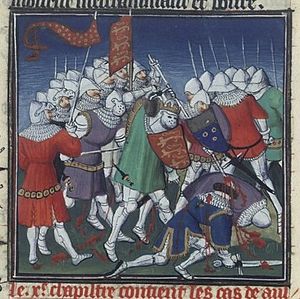Battle of Tinchebrai
| Battle of Tinchebray | |||||||
|---|---|---|---|---|---|---|---|
| Part of Henry I of England's invasion of Normandy | |||||||
 Late medieval picture from the 15th century of the Battle of Tinchebray |
|||||||
|
|||||||
| Belligerents | |||||||
| Robert Curthose, the Duke of Normandy | Henry I of England | ||||||
| Commanders and leaders | |||||||
|
William, Count of Mortain Robert of Bellême, 3rd Earl of Shrewsbury |
Ranulf of Bayeux Robert de Beaumont, Count of Meulan William de Warenne Elias I of Maine Alan IV, Duke of Brittany William, Count of Évreux Ralph of Tosny Robert of Montfort Robert of Grandmesnil |
||||||
| Strength | |||||||
| Unknown | Unknown | ||||||
| Casualties and losses | |||||||
| Unknown | Unknown | ||||||
Coordinates: 48°45′54.9″N 0°43′40.2″W / 48.765250°N 0.727833°W
The Battle of Tinchebray (alternate spellings Tinchebrai or Tenchebrai) was fought 28 September 1106, in Tinchebray (today in Orne département of France), Normandy, between an invading force led by King Henry I of England, and his older brother Robert Curthose, the Duke of Normandy. Henry's knights won a decisive victory, capturing Robert and imprisoning him in England (in Devizes Castle) and then Wales until Robert's death (in Cardiff Castle).
Henry invaded Normandy in 1105, taking Bayeux and Caen. He broke off his campaign because of political problems arising from the Investiture Controversy. With these settled, he returned to Normandy in the spring of 1106. After quickly taking the fortified abbey of Saint-Pierre-sur-Dives (near Falaise), Henry turned south and besieged Tinchebray Castle, on a hill above the town.Tinchebray is on the border of the county of Mortain, in the southwest of Normandy, and was held by William, Count of Mortain, who was one of the few important Norman barons still loyal to Robert. Duke Robert then brought up his forces to break the siege. After some unsuccessful negotiations, Duke Robert decided that a battle in the open was his best option.
...
Wikipedia
